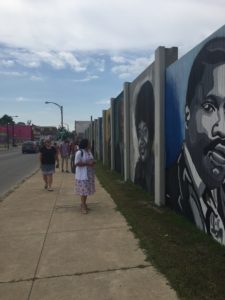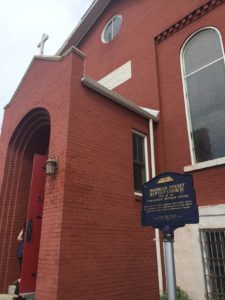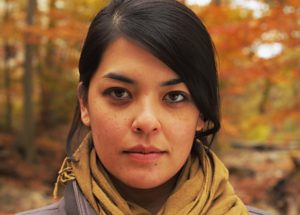By Rebecca Chan, Program Officer for Creative Learning, LISC

As I landed in Buffalo for the second PLACES site visit of 2018, I felt a sense of excitement and trepidation. I was eager to reconnect with my PLACES cohort and to get to know a new-to-me community and place, yet I also knew that the days ahead would be thought-provoking and challenging. As I advance in my personal racial equity journey, the more I can’t “un-see” the way power, race, and inequity shape our environments. My analytical framework sharpens, coming more clearly into focus with each article I read or workshop I attend, the language and tools to communicate crystallizing in turn. Participating in the PLACES Fellowship has only accelerated this process of thinking, feeling, and acting. It is at once exhausting and invigorating.
We opened our Buffalo site visit with a challenge: How will we create a bridge between what we learn during this convening and our own practice? How does the work of racial equity impact one’s personal leadership style, and what will make us proud of how we show up?
This challenge is one that I have wrestled with for years, and also one that, for me, raises more questions than answers. What does it mean to be a person of mixed race, more often than not enjoying the privilege of moving with fluidity between white and non-white spaces? And, as a community development professional that works nationally, how do I exert anti-racist influence, power, and perspective when I am not fixed in place, a perpetual outsider preaching the importance of rootedness and equity? How can these experiences and perspectives translate to my authentic anti-racist leadership style?
Fortunately, the Buffalo PLACES itinerary provided no shortage of great examples on which to draw and learn. We heard from leaders within Buffalo’s smart development and environmental justice community, visited a massive workforce development project, and met with local youth leadership. We heard from leaders in Buffalo’s education space, as well as our philanthropic peers at the Community Foundation for Greater Buffalo, and caught a glimpse of Buffalo’s Underground Railroad history. All in all, a fairly comprehensive look at Buffalo’s community development landscape.
Weeks later, I find myself still mulling over our learning module on implicit bias led by the formidable Dr. Ursaline Bankhead. Implicit or hidden bias refers to the pervasive and subconscious feelings and attitudes that affect our actions and decisions, often associated with race, ethnicity, age, or appearance. In other words, your blind spots. Dr. Bankhead’s lecture was an excellent opportunity to turn the lens on ourselves and think about the ways that we have been unknowingly conditioned to discriminate and judge.

While our time with Dr. Bankhead did not magically reveal my own implicit biases, the training does have me thinking about how racism manifests in extremely ordinary ways. Like a fire drill, I mentally practice what I will say and how I will act when confronted with overtly racist incident. Yet applying an implicit bias lens to the practice of racial equity tells us that we need to be rooting out and undoing our own banal participation in racist systems and constructs. Yes, the work of racial equity is stopping racist action punctuated in a moment, and it is the far less exciting daily practice of observing our own complicity and adjusting our actions and decisions. In the practice of racial equity, there is no good or bad, black or white, racist or not racist. These binaries are constructs, and in fact preserve racism by perpetuating the archetypal “Bad Racist.”
How does this translate to my leadership style? I strive to be a leader who acknowledges that we all have biases and to be generous in spite of this, to never dismiss or discount the experience of others, and to humanize those with perspectives that differ from my own. In a world of grant applications, never-ending emails, and deadlines, I hope to slow down and operate from of platform of humility and nuance.
I am immensely thankful to LISC for investing in my participation in this program; to TFN for curating an amazing experience in Witchita and Buffalo; and for my PLACES cohort for providing space for reflection, patience as we struggle and grow together, and the brain trust as we build the bridge back to our own practice.
About the Author
 Rebecca Cordes Chan, is the program officer for the National Creative Placemaking Program at Local Initiatives Support Corporation (LISC), a national community development intermediary that provides loans, grants, equity, and technical assistance in underinvested neighborhoods. Prior to joining LISC, Rebecca served as a program officer for the Robert W. Deutsch Foundation, the first Creative Placemaking Fellow for Reinvestment Fund, and Program Director for Baltimore’s Station North Arts & Entertainment District. Rebecca has been recognized as a Fellow of the Salzburg Global Forum for Young Cultural Innovators (2015), a Warnock Foundation Baltimore Social Innovator (2014), and was named to the Baltimore Sun’s “10 People to Watch Under 30” list (2014). She received her MS in Historic Preservation from the Graduate School of Design at the University of Pennsylvania, and a BA in Anthropology from the University of Illinois, Urbana-Champaign.
Rebecca Cordes Chan, is the program officer for the National Creative Placemaking Program at Local Initiatives Support Corporation (LISC), a national community development intermediary that provides loans, grants, equity, and technical assistance in underinvested neighborhoods. Prior to joining LISC, Rebecca served as a program officer for the Robert W. Deutsch Foundation, the first Creative Placemaking Fellow for Reinvestment Fund, and Program Director for Baltimore’s Station North Arts & Entertainment District. Rebecca has been recognized as a Fellow of the Salzburg Global Forum for Young Cultural Innovators (2015), a Warnock Foundation Baltimore Social Innovator (2014), and was named to the Baltimore Sun’s “10 People to Watch Under 30” list (2014). She received her MS in Historic Preservation from the Graduate School of Design at the University of Pennsylvania, and a BA in Anthropology from the University of Illinois, Urbana-Champaign.
